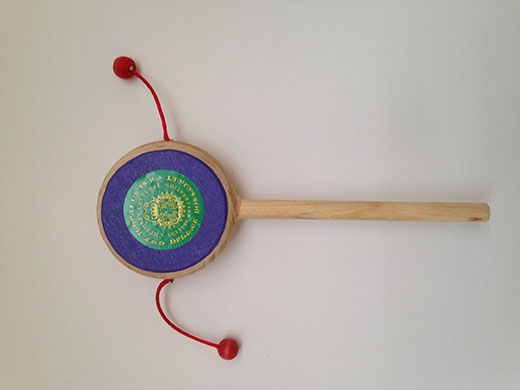Cherokee — or more specifically, the local tourism industry — does love its moonshine souvenirs. This wood and wire creation stands 3 inches tall.
Tag: cherokee nc
New in the collection: Cherokee eclipse-watching kit
The cardboard shades were pretty much standard issue for watching the 2017 total solar eclipse, but the noisemaker is specific to Cherokee legend.
Tribal storyteller Mike Crowe of the Museum of the Cherokee Indian told Blue Ridge Public Radio, “A long time ago, whenever there was an eclipse, they had an explanation for this. The frog would come up, and he would swallow the sun. They would come out and bang the drum and make loud noise and this would frighten the frog away. After a time, things would return to normal. Everything would be okay.”
Video of the eclipse watch in Cherokee, including a brief but apparently successful demonstration of frog-frightening.
Cherokee face ‘existential struggle’ in marketplace
“There’s a cultural amnesia about what it means to be Native American, says Cherokee woodcarver Christy Long. ‘When you look at what people understand about a native, you get people who only understand natives from [a] romantic point of view.’
“Such misconceptions mean tourists to Cherokee seek headdresses and dreamcatchers — neither of which are native to the tribe. That doesn’t mean, however, that headdresses and dreamcatchers aren’t sold. ‘When you’re trying to make a living, you still have to look at those things that people will purchase, so that you can make money to feed your family,’ says Long. ‘It’s [an] existential struggle for a native person.’ ”
— From “Cherokee artists consider life beyond the mountains” by Thomas Calder in Mountain Xpress (Dec. 22)
From the Miscellany vault: Examples of Cherokee image vs. reality in postcards and pinback buttons.
Weekend link dump: Fog of war, roots of rivalry
— Vietnamese-American writer sets latest novel in Boiling Springs, peoples it with Virginia Dare, Wright Brothers and slave poet George Moses Horton.
— Fog of war hinders recount of state’s Confederate dead.
— Student paper at N.C. State emphasizes importance of campus history, such as “old rumors that our rivalry with UNC-Chapel Hill started when UNC students urinated in the old well in Yarborough Square.”
— Ceremony at recently discovered Surry County slave cemetery honors “Bob and Jacob, Melissa and Isabelle and Charles, Sarah and Delsie.”
— Before Rupert Murdoch took over, how many Wall Street Journal stories did you see datelined Cherokee?
Seven sites win roadside recognition
Thanks to Michael Hill for this list of state highway historical markers approved by the advisory committee May 25:
— Pea Island Lifesavers. Only U.S. Lifesaving Station manned by black crew. Led by Richard Etheridge, 1879-1899.
— George H. White, 1852-1918. Represented the state’s “Black Second” district, U.S. House, 1897-1901. Last black Southerner in Congress for 72 years. Lived two blocks east. [Tarboro]
— Anna J. Cooper, 1858-1964. Educator, orator & early black feminist. Graduate, St. Augustine’s. Author, A Voice from the South (1892). Grave 2 1/2 blks. S. [Raleigh]
— Fairgrounds Speedway. After 1928 popularized Indy-style car racing. Site hosted the last NASCAR race on dirt track, 1970. Half-mile oval was 250 yds. SW. [Raleigh]
— Lewis Leary, 1835-1859. Free black abolitionist & conspirator in 1859 with John Brown in attack on U.S. arsenal at Harpers Ferry. Killed in assault. Lived in this vicinity. [Fayetteville]
— Omar Ibn Said, ca. 1770-1863. Muslim slave & scholar. African-born, he penned autobiography in Arabic in 1831. While living in Bladen Co., worshipped with local Presbyterians. [Fayetteville]
— Nimrod Jarrett Smith, 1837-1893. Principal Chief, Eastern Band of Cherokee, 1880-1891. Led incorporation of Band & centralization of Tribal government on his property, here. [Cherokee]
Expected by week’s end: Details on each marker.



